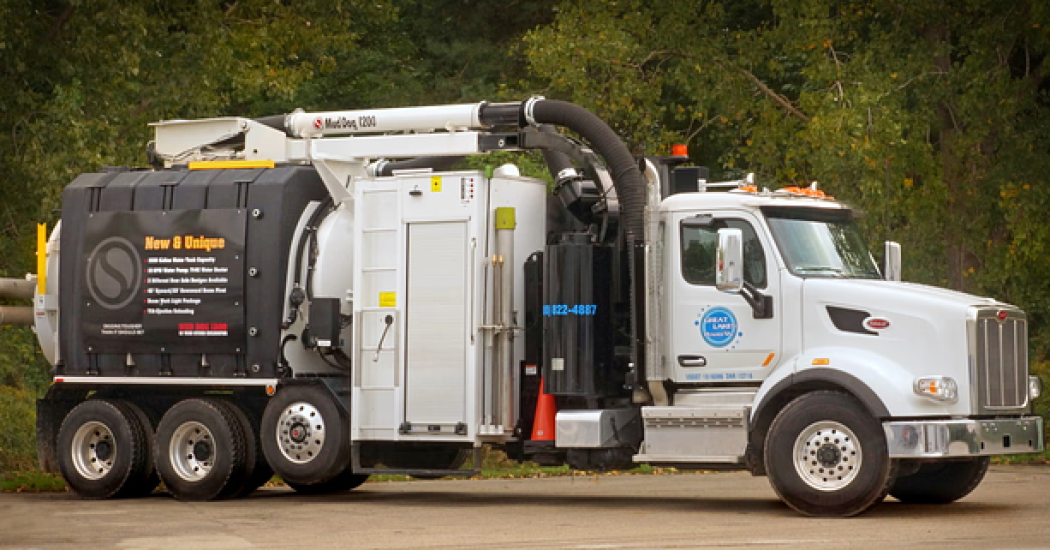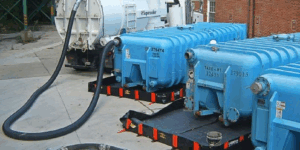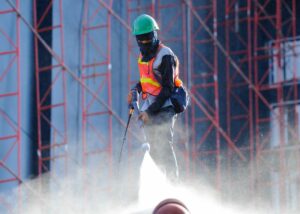In the world of underground infrastructure, precision and safety are paramount. As cities expand, utility lines multiply, and aging infrastructure is replaced, the risks associated with excavation grow. Traditional digging methods like backhoes and mechanical trenchers have long posed hazards to underground utilities, leading to costly damages, service interruptions, and potential safety hazards. Additionally, in certain industrial environments, these methods can disturb combustible dust, creating dangerous conditions that could lead to fires or explosions. Fortunately, hydro-excavation has emerged as a safer, more accurate alternative for exposing underground utilities.
In this blog, we’ll explore how hydro-excavation protects underground utilities, enhances job site safety, and improves operational efficiency for utility companies and municipalities. Let’s dive in.
What Is Hydro‑Excavation?
Hydro-excavation is a non-destructive digging method that uses a combination of high-pressure water and a powerful vacuum system to safely expose underground utilities. The pressurized water breaks up soil, and the resulting slurry is removed through a vacuum hose into a debris tank.
Unlike mechanical digging equipment, hydro-excavation offers precise soil removal, minimizing the risk of damaging pipes, cables, and other subsurface structures.
Why Protecting Underground Utilities Matters
Across North America, millions of miles of buried utility lines deliver water, electricity, gas, and telecommunications. According to the Common Ground Alliance (CGA), thousands of underground utility strikes occur each year — resulting in public safety hazards, costly repairs, and significant service disruptions.
Protecting these utilities during excavation projects isn’t just about regulatory compliance — it’s about public safety, environmental protection, and operational continuity.
How Hydro‑Excavation Enhances Utility Protection
Precision Excavation
One of the standout benefits of hydro-excavation is its ability to perform highly precise, controlled digging. Operators can target specific areas to expose pipes, cables, and conduits without disturbing surrounding soil unnecessarily. This is particularly beneficial when working near dense clusters of utilities or delicate infrastructure.
Example: In urban environments where water mains run alongside fiber optic lines, hydro-excavation allows crews to safely uncover specific utility lines without collateral damage.
Utility Mapping and Verification
Before any excavation project begins, accurate utility mapping is essential. Hydro-excavation is often used for potholing or daylighting, a process of digging small, exploratory holes to locate and visually confirm the depth and position of underground utilities.
This verification step helps cross-check records from one-call services or GIS mapping, ensuring that excavation plans align with real-world conditions.
Damage Prevention and Safety
Mechanical digging can inadvertently cut, crush, or rupture utility lines — causing power outages, gas leaks, water contamination, or communication failures. Hydro-excavation dramatically reduces this risk by eliminating metal-to-metal contact with buried infrastructure.
For utility companies and municipalities, this method enhances worksite safety for crews and the public alike. The reduced chance of utility strikes lowers the risk of injuries, explosions, and environmental hazards.
Accurate Pipe and Cable Exposure
When replacing or repairing existing utilities, exposing infrastructure cleanly and completely is crucial. Hydro-excavation ensures clear, unobstructed visibility of pipes, conduits, and cables without damaging protective coatings or structural integrity.
This is particularly useful when working on aging or brittle infrastructure, where even minor impacts from mechanical equipment could lead to cracks or leaks.
Ideal for Tight or Congested Areas
In densely populated areas or locations with complex underground networks, maneuvering heavy machinery may not be feasible. Hydro-excavation trucks can park a safe distance away while extending hoses to access hard-to-reach excavation points.
This makes hydro-excavation ideal for:
- Urban streetscapes
- Residential neighborhoods
- Industrial facilities
- Environmentally sensitive areas (wetlands, parks, etc.)
Enhanced Excavation Accuracy
When it comes to excavation accuracy, few methods can match hydro-excavation. Operators can control the water pressure and excavation depth, minimizing over-digging and site disruption. This improves project timelines and reduces material backfill costs.
Precise excavation also preserves surrounding infrastructure and landscaping, making site restoration faster and more cost-effective.
Applications of Hydro‑Excavation in Utility Work
Hydro-excavation is versatile and widely used for:
- Potholing/Daylighting: Verifying utility locations before trenching.
- Trenching: Digging narrow trenches for new utility lines.
- Slot Trenching: Creating precise, linear cuts for pipes or cables.
- Utility Repair Access: Exposing damaged lines for repair or replacement.
- Pole Installation: Digging holes for utility or traffic signal poles.
- Debris Removal: Cleaning storm drains, culverts, and catch basins.
Environmental and Operational Benefits
In addition to its safety advantages, hydro-excavation offers several environmental and operational benefits:
- Reduces soil erosion and sediment runoff.
- Minimizes disturbance to nearby vegetation and ecosystems.
- Faster clean-up and restoration due to controlled soil removal.
- Year-round operability, even in frozen ground when paired with heated water systems.
For municipalities, this means lower project costs, reduced environmental impact, and improved public perception of infrastructure projects.
Final Thoughts: Why Municipalities and Utility Companies Choose Hydro‑Excavation
As cities modernize and utility networks grow more complex, the need for safe, precise, and efficient excavation methods has never been greater. Hydro-excavation offers a proven solution that protects underground utilities, reduces project risks, and enhances operational efficiency.
Whether you’re managing new installations, maintenance projects, or emergency repairs, integrating hydro-excavation into your excavation practices ensures safer outcomes for your crews, infrastructure, and the communities you serve.
Ready to enhance your utility excavation process? Choose hydro-excavation — where precision meets protection.
FAQs
Yes — hydro-excavation is considered one of the safest methods for exposing various utility lines, including water, gas, electric, fiber optic, and sewer pipes. Operators adjust water pressure settings based on the soil type and proximity to utilities.







